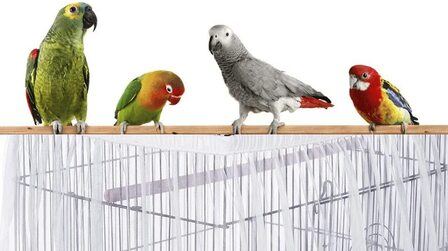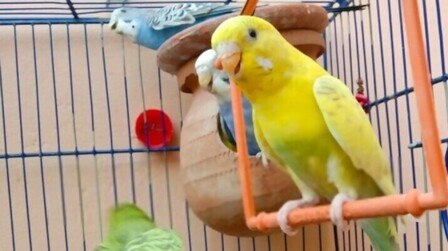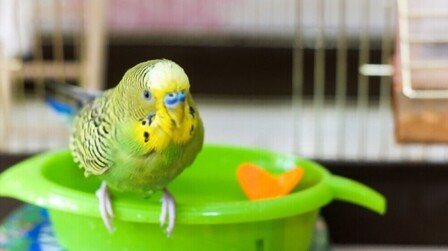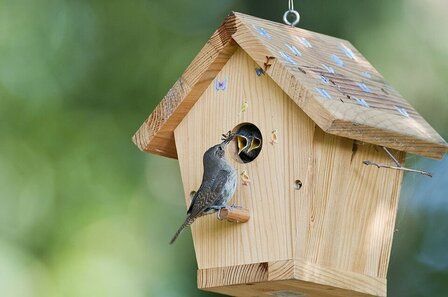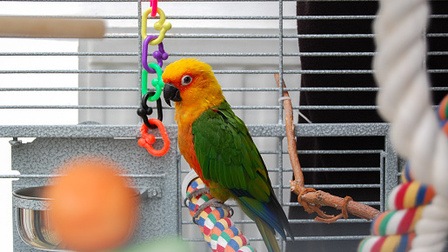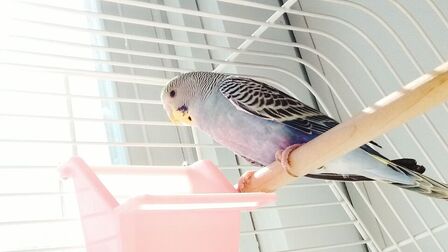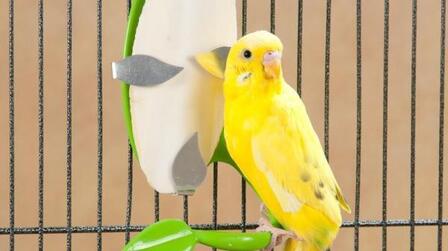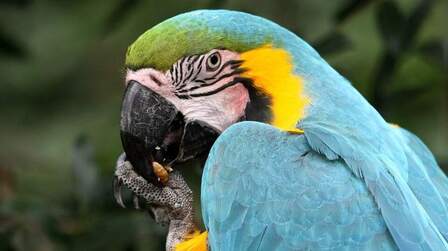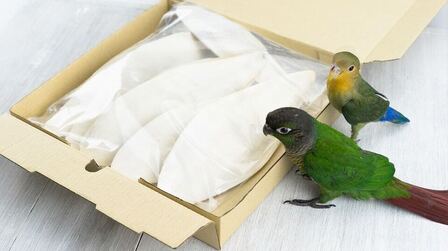Wide range of bird toys such as mirrors, ladders, swings, and ropes. Some bird toys seem flimsy, leaving you wondering if you'll break them on first use.
Some common questions when buying; How to choose bird toys? How many bird toys does a bird need? And are all those ropes and artificial colors safe?
Find out with us below!
1. Consider the size
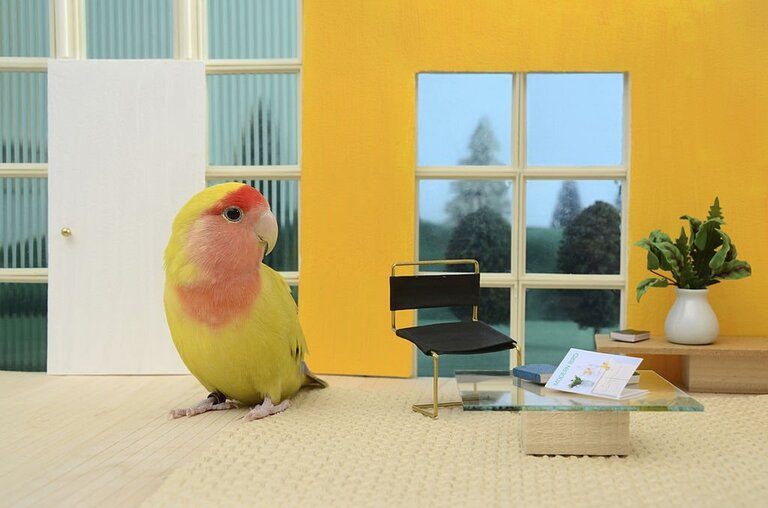
Any toy is potentially unsafe if the size isn't right for the bird. As small bird toys are often made with parts that could pose a choking hazard to large birds and vice versa, large bird toys may present an entrapment hazard. Often small brittle plastic parts that are perfect for a small bird, but break easily into sharp shards when subjected to the force of a large bird's beak.
2. Construction aspect

Often toys that are 100% safe for one bird can pose a risk to another. Both the design and the suitability of the material must be evaluated by the bird owner.
3. Design

Poorly designed toys can pose a risk of injury to birds.
And some questions arise when someone buys a bird toy:
- What size is the hoop that the bird is in danger of getting its head stuck in?
- Can small openings pose a toe or nail hazard?
- What long slits of rope, leather, or chain could pose a strangulation risk if the bird tosses the toy and it wraps around its neck?
- Is the type of hardware used appropriately for the size of the bird for which the toy is specified?
- What small parts, if removed, could cause soft tissue damage to the bird's mouth?
4. Materials

Many reputable manufacturers choose to use only the safest ingredients to make toys. However, bird-safe materials can be extremely dangerous for a large bird.
Wood
Used in toys is the word "safe" tree. Safe woods include Pine, Balsa, Bamboo, Beech, Birch, Basswood, Cajeput, Dogwood, Douglas Fir, Hickory, Poplar, Maple, Walnut, Ash, Apple, Elm, Cactus (Cholla), and Manzanita.
Unsafe woods include Cedar, Cherry, Plywood, and Oak.
Make sure the wood is only stained with non-toxic food coloring or vegetable dyes.
If you want to have parts painted as ABC blocks, make sure you only use non-toxic paint that is safe for young birds.
Wire
Ropes of 100% natural fibers such as cotton, hemp, jute, or sisal should be used in bird toys.
They need to be properly maintained, and the bird's beak and claws are manicured.
Inspect bird rope toys daily and cut back or discard wire toys when they become frayed or pose a danger to their bird.
Chain

Links are sized safe for the bird. If a bird's toes get caught in the links, the result can be broken fingernails, toes, or legs.
Chain length is also a factor to consider. A long chain can be wrapped around a bird's neck during a vigorous play session. When wood components are chopped, a chain hazard can develop.
Latches
Do not buy toys that use a detachable key ring, spring clip, or metal shower ring as a lanyard.
Small pieces of hard material can be accidentally swallowed or cause a wound in the mouth.
Quick-link or Pear link type connectors are recommended for attaching the toy to the bird's play area. This type of lanyard is the least likely to cause injury.
Plastics
The plastic component must consider the nature of the soft and brittle plastic components) relative to the size of the bird.
Large birds should not be given brittle plastic as they break very sharply, cuts will form and if swallowed accidentally can rupture organs.
Hard plastic toys for parakeets and parakeets should not be given to larger birds.
Skin
It is recommended to use vegetable tanned leather for bird toys.
Avoid buying toys with dyed or chemically tanned leather, as most toys are toxic to birds with chromium and formaldehyde.
Change the skin if you find it dirty or wet. Bacteria will proliferate under these conditions.
When hanging toys with a leather cord, rope, or chain, avoid leaving a long cord between the toy and the cage. Birds can get skin wrapped around their necks and strangled when entertained. Tie the toy near the bars of the cage.
Ring

Toys have large plastic rings or chains, make sure the ring is the right size so the bird can't get its head stuck in the ring and suffocate.
Also, be careful with toys that have multiple loops directly on each other.
Bell
If the bird is mechanically inclined and the bell clamp can be removed, the possibility of swallowing/choking will occur.
Make sure the bird can't remove the belt clip. You should know that it is not fastened, take it off.
Make sure the clip is lead-free as lead can dent the clip with your fingernails.
Do not buy toys that use jingle bells, toes can get stuck and cut in wide to narrow openings.
Buy bells with bull designs or freestyle bells.
The bell size should be suitable for the bird so that it can withstand the strength of the beak.
5. Types of bird toys

Foraging toys
Providing for one of the main natural behaviors of birds is the activity of foraging, and retrieving their food. If the bird's feeding takes up a lot of the parrot's time, this is a pretty useful toy.
Favorite foods and snacks or chewable materials are placed inside. Then they will figure out how to get them.
There are two types of feeding toys, reusable ones made from super-strong plastic, acrylic, and polycarbonates like those from Creative Foraging and chewable ones like Parrot Pinatas.
The original forage wheel is also an interactive creation toy.
Chewable and Shreddable toys
The Parrot's beak is always growing and chewing helps to keep the bird's beak trimmed and in top shape. Your pet relies on its beak for food, using it as a third leg for its acrobatic movement.
Among them, wooden and rope toys, cardboard and paper toys, and those made with natural textile materials such as palm leaves, willow, and grapes are popular; Great for keeping beaks busy chewing, preening, and chopping.
Foot toys

Climbing and Swinging toys

It supports exercise and shows the acrobatic skills of birds, promoting exercise through play.
Activity and Trick toys
Help your bird enjoy playtime together with activities and trick toys. Through it, the bird can learn new skills, like counting, color recognition, or even riding on the Parrot's special roller skates.
6. Mental and physical stimulation

Being physically and mentally stimulating is important when buying toys for your pet. Most birds like to test their intelligence and solve problems. Therefore, you should look for brightly colored items with a variety of textures, sounds, and smells to stimulate your bird's senses. Furthermore, the toys help birds use their muscles and improve coordination, ensuring they stay strong and can fly with ease.
7. Why do you need to change bird toys?

First, you probably won't know what will affect your bird. Sometimes it can lead to injury if you don't change the toy.
Also, look for cracked plastic and frayed wire sticking out of the toy. Watch out for dirt on toys. Do not attempt to clean or attempt to repair the toy at this time. Instead, throw it out and add a new toy to the cage.
Conclusion
Bird Toys are important to your parrot's well-being, and they serve as an alternative outlet for many of the activities the bird will engage in every day, in the wild.
Although there is no safe item, what you need to pay attention to is how to choose materials to ensure the safety of the bird's health.


